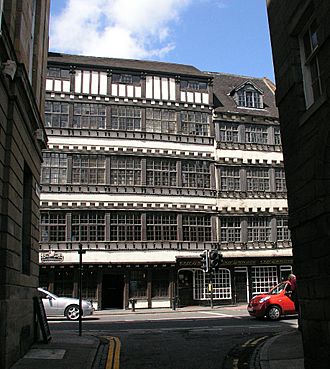Bessie Surtees House facts for kids
Quick facts for kids Bessie Surtees House |
|
|---|---|

|
|
| General information | |
| Location | Tyne and Wear, England |
| Address | Bessie Surtees House, 41–44 Sandhill, Newcastle-upon-Tyne, NE1 3JF |
| Coordinates | 54°58′07″N 1°36′30″W / 54.9686°N 1.6084°W |
| OS grid | NZ249637 |
| Owner | Historic England |
Bessie Surtees House is the name for two old merchant houses in Newcastle upon Tyne, England. They are located on Sandhill street, right by the River Tyne. These houses were built a long time ago, in the 1500s and 1600s.
Even though people often call them just 'Bessie Surtees House,' the property actually has three parts. These are Bessie Surtees House, Milbank House, and Maddison House. An owner in the 1900s, Lord Gort, gave them these names. The buildings are special because they show a beautiful and rare style called Jacobean architecture. This style was popular when King James I ruled England. You can visit an exhibition inside to learn about their history. The building is also the main office for Historic England in the North East of England. It is a very important historical building, known as a Grade I listed building. This means it is protected because of its special history and architecture.
The first record of a house on this spot dates back to 1465. At that time, a local lawyer named Robert Rhodes sold the house to John Belt.
The Story of Bessie Surtees House
This house is most famous for a romantic story. It was where Bessie Surtees, who later became Countess of Eldon, ran away with John Scott. John Scott later became a very important judge, known as the Lord Chancellor.
Over time, the house was divided into smaller parts and rented out. In 1880, John Clayton bought the house. He also bought Milbank House, which was next door. In 1930, a man named SR Vereker, who later became Lord Gort, restored the house. He hired an engineer, R.F. Wilkinson, to add old features from other 17th-century buildings that were being torn down.
Newcastle City Council bought the house in 1978. They then leased it to English Heritage in 1989. In July 2009, the roof of the house was marked with spray paint. When Historic England was created in 2015, it took over the lease of the property. Historic England still uses the house as its office for the North East of England today.
The house is a popular place to visit during special events. These events include The Late Shows and Heritage Open Days, which happen every year. During these times, people can see parts of the house that are usually not open to the public.
Milbank House History
Milbank House has a brick front and was built around the same time as Bessie Surtees House. It was also originally made with a timber frame. In 1741, its owner, Robert Carrick, changed its front to a more modern Georgian brick style. From 1741 until 1757, the building was used as a coffee house.

